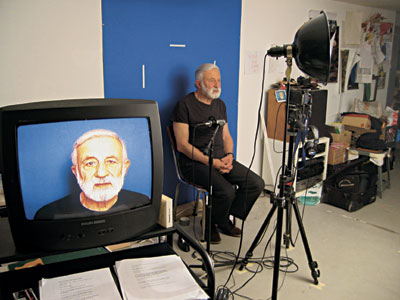| Umělec magazine 2006/1 >> Saucy Sounds | List of all editions. | ||||||||||||
|
|||||||||||||
Saucy SoundsUmělec magazine 2006/101.01.2006 Arlene Tucker | profile | en cs |
|||||||||||||
|
Reasons for adapting one’s accent vary, but what it comes down to is how one chooses to assimilate to a specific surrounding. Do they want to emphasize differences or emphasize similarities? All the facets of self-identity and assimilation are brought out through how one inherently accents his/her thought. Through the spitting mess of consonants and vowels, the sound pattern of Standard American English talks its way into a profound part of our lives. Everybody’s blank palate of a tongue is developed with Morse coded airways we just call words. Following the line starting from the brain, a thought to be voiced is made, finally landing in an ear.
Landing in Brooklyn, New York, Nina Katchadourian has taken the rolling “R”’s and diphthongs of an accent to create the video installation Accent Elimination. Sixteen hours of footage condensed into a twelve-minute video plays with the concept of abstracting accents from a person as if it is a physical object. Nina compared it to an heirloom, something that could be taken from one person and given to another, the way an object could. Nina, her parents, and their speech coach Sam Chwat run through the process of picking up a new accent, which we realize is like learning a new language. The Katchadourian household is filled with accents. Nina’s Armenian father has a tool belt of languages carrying Armenian, French, Swedish, and Arabic. Nina’s mother comes from a Swedish-speaking minority in Finland and adventured her way to learning how to speak seven different languages. Naturally, with such a riot of cultures and languages, Nina and her brother were brought up sleuthing it together. As much as they have the speaking down just fine, neither Nina nor her brother were ever able to pick up their parent’s unique way of pronouncing English. Thus this project became the medium to attempt this undertaking. Nina was horn-mad about the tons of posters hanging around New York City. These proclaimed the opportunity to reduce, diminish, replace, and eliminate one’s accent. She thought of it as being mildly violent. Daunting and dire as it may sound, the purpose of speech companies is to allow people with foreign accents to communicate more efficiently in the States, not to eradicate one’s identity or ethnicity-- but does it? The classes took place in Sam Chwat’s “stuffed to the gills” with anything imaginable office, as Nina describes it. For two intensive weeks Chwat worked with Nina and her parents to switch their accents. Nina would learn both her parents’ accents and her parents would learn hers. They practiced from a script written carefully by her parents, exampling a typical introduction with a stranger. Nina says, “The idea is that my mother is at a party, a person is asking her questions and five minutes into the conversation she has had to tell them her whole life story, and knows nothing about the other person.” Despite Nina’s mother’s golden ear she mostly had trouble with the “o” sound because the Swedish “o” is so short. For example, a word she had difficulty with was Wisconsin. Her short "o’s" were slipping into the dip of the "con.” Sam labeled this as a north south word because she had to pull her mouth long. Getting her to physically make this certain face was the key to this Standard sound. On the other hand, Nina’s father was turning the “th” into “d,” which was a result from his native Armenian language. According to the New York Speech Improvement Services, Standard American English is also known as “Non-regional American English” due to the fact that this learned accent is contrived. Its sound pattern of forty-four vowel and consonant combinations makes the speaker sound American without drawing attention to a specific region. Even though Nina’s parents have been here for forty years their accents have not conformed to the common sands of the West coast. Sam gave Nina’s mother a high appraisal for her two-week effort because she adapted so fast to this new accent. It probably would take a good year of training for them to completely lose their accent. Nina picked up a few tricks on how to mimic her parents but would still need strong vocal discipline to sound like them. After the sessions were over, the only one who would slip into this new way of speaking was Nina’s mother, which was too bizarre for the rest of the family to handle. Her speaking in another manner was like being possessed by the accent lord. Another personality was coming out of her, so it soon stopped because Nina wanted her mother back. Pouring more sauce over one’s wordy thoughts is the key to the American way of speaking according to Nina’s father. Whenever he wasn’t sounding American enough, he would say, “Pour more sauce! Pour more sauce!” to slur all that mess together. Succeeding in perfecting the switched accent wasn’t the importance of this project, but the process of getting there. This video leaves the viewer self-reflecting questions such as what an accent is and where yours comes from? So in the end, just keep your ear open and you’ll be surprised what will come of it. The sauce is up to you. Accent Elimination was shown at Sara Meltzer gallery, www.sarameltzergallery.com, in New York in May 2005.
01.01.2006
Recommended articles
|
|||||||||||||







Comments
There are currently no comments.Add new comment